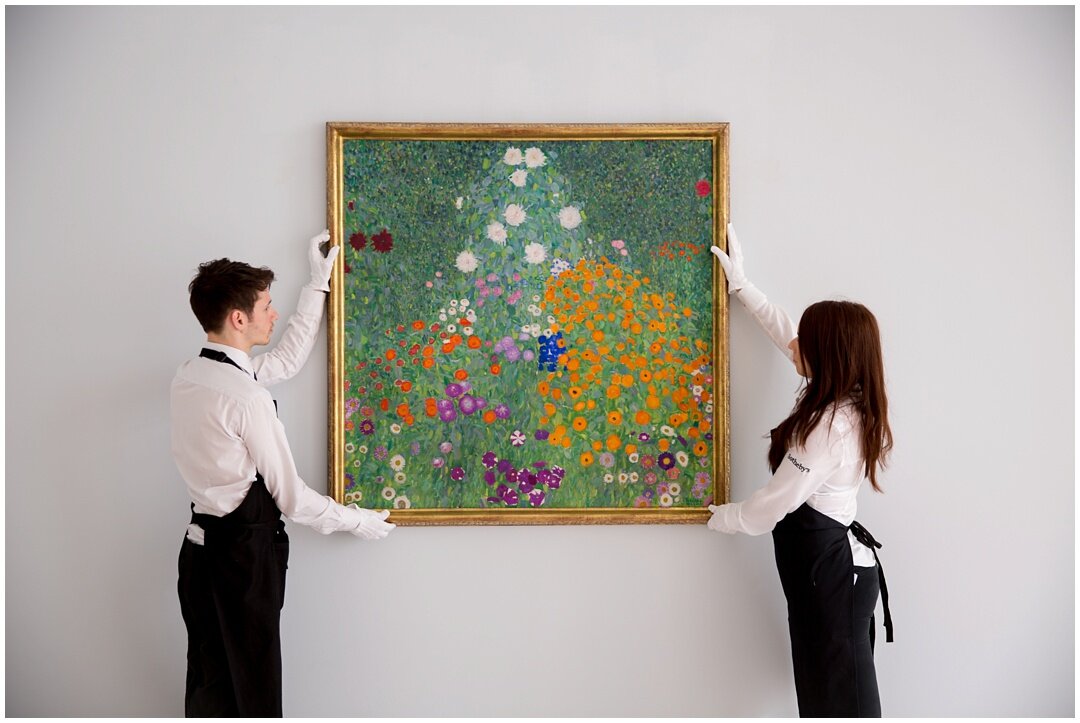Off the Wall: FAQ’s on Handling Art
Art Handlers with Le Roi à la Chasse II by Kehinde Wiley
Handling fine art can be a daunting experience and is one of the most underrated forms of expertise in the art market. Can I pick that painting up? What are nitrile gloves? With the help of experienced art handler and Sotheby’s Institute of Art MA Logistics student Samantha Simmons, Off the Wall: FAQ’s on Art Handling is here to invigilate on the practical side of things.
What are the most important things to think about before handling art?
You want to handle art as little as possible. The more a work moves, the more it’s at risk of being damaged. Before picking an artwork up, you have several questions to answer- how necessary is that move? where is the artwork currently and what is its destination? What route is required to get it there and does it posit any complications? Can you take an elevator or are stairs the only option? This is the most important step and is forgotten frequently. The easiest example is the ‘artwork doesn’t clear the door’ issue.
What are the most important things to consider while handling art?
Spatial awareness and an understanding of your capability is key. Exercise good judgement to get artworks where they need to be, as safely as possible. Don’t try to force things or rush.
Understand the object. Where are its strongest and weakest points? Does it come apart? Monitor yourself while you move the object. Make sure you can see the object and your surroundings so you leave no room for accidents. Also make sure nothing you are wearing/ have on you could potentially damage the object (no keys sticking out of pockets or necklaces dangling, etc.).
Art Handlers with Gassed by John Singer Sargent.
Are gloves important? What types of gloves?
Gloves can be important depending on the situation. While white gloves are often expected for appearances, they can actually make handling trickier at times because of how smooth and soft they are. Nitrile gloves, changed regularly, tend to be the best in my opinion. They have a good grip and do not leave behind sweat or fingerprints like latex gloves. However, very clean hands are often your best alternative, especially when working with objects that need an extra soft touch. Very frequent diligent hand washing can be just as effective when working with delicate objects and surfaces.
What type of equipment can you use?
There are all kinds of nifty tools out there for handling art. One of the most common tools is a simple skate. Its larger cousin is the A-frame. Ratchet straps and cotton ties are good ways to secure an artwork safely to its moving counterpart. Make sure there is a buffer between an artwork with a sensitive surface and any straps. For any skates or other mobile assistance, make sure the wheels are made of rubber. This will cut down on vibrations and generally make the move much easier.
Art Handlers with Untitled (SEX) by Michael Craig-Martin.
How do you lift or carry a basic painting?
Two hands on either side of the work, never touch the paint surface or weak points. Never slip your fingers between the canvas and the stretcher bars. It’s tempting. It feels like a handle. Don’t do it.
If it’s heavy, set the painting on a skate or A-frame. If hand-carry is your only option on a large/heavy painting, then make sure you have two people. A good rule of thumb is that if an object weighs more than 50 lbs, use two people to move it.
If possible, I also prefer holding the work so that the painting is facing me. Then, I at least know that the surface will not be bumped or scratched by something like someone else's negligence.
What about a sculpture?
Again, two points of contact is important and always avoid sensitive surfaces or weak points. Be mindful of your route. If you already have the object in a safe crate, don’t make more risky work for yourself by unpacking it. Simply carry it in the crate or set that crate on a skate and roll it where it needs to be (carefully, of course!).
For big sculptures or heavy objects, never try to shimmy or pivot them. It creates a dangerous situation for yourself and the artwork. The same 50 lb rule applies to sculptures as paintings.
I’m an artist. Should I be including instructions on how to handle my artworks?
You don’t have to include instructions, but it’s always helpful for professional handlers or other staff to understand how you prefer this object be handled, cleaned (if relevant), or packed. You understand your work the best; where the weak points are and where extra care should be taken, and where the object is most robust. You know where you’ve been handling it because you’re the one handling it all along its life before it goes to an exhibition.
Art Handlers with Bauerngarten by Gustav Klimt.
Is art handling a profession? What are the qualifications to be a handler?
Yes, and technicians are some of the coolest and most knowledgeable people when it comes to art. You either can be a freelance technician and some companies like Crozier Fine Arts enable their technicians to undergo complex training to best handle idiosyncratic objects. Art handlers are organised, analytical, and sensitive to unique works of art.
Thanks, Sam!
For more information on Art Handling, check out these further resources below:
https://uovo.art/the-life-of-an-art-handler-behind-the-scenes/
Veda Lane,
MADE IN BED’s Head of Features





